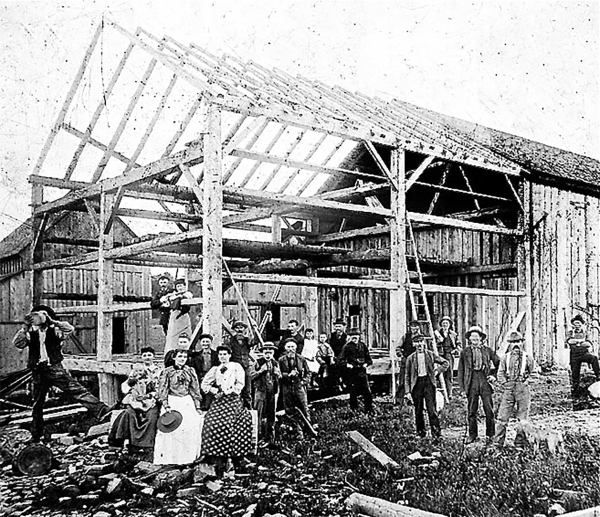This is the sixteenth in a Series of Reminiscences by E. R. Brown. Brown was born in Pulaski County on August 9, 1845. His writings are abstracted from the Pulaski County Democrat on microfilm housed in the Pulaski County Public Library, Winamac, Indiana. Find links to earlier entries at the end of this article.
Published in Pulaski County Democrat, June 8, 1922
Many of these old matters have been referred to in certain papers in recent months and it has been interesting to note how nearly alike customs were in early days all over Indiana, if not the entire middle west.

I have said previously that my parents, on coming here, built their own log cabin. The reason was that there were then no white people near from whom they could accept a sacrifice in the way of assistance. Barely two families lived in the vicinity, one on adjoining land having, besides the father, two or three well-grown boys. Both families were most earnest and free hearted in offers to help. They had come only the summer before and that they should clear land and get crops planted for themselves was imperative. Therefore, by selecting smaller logs and using their horses to the best advantage, my folks managed to get along. By the way, referring to these horses prompts me to say that, among some serious drawbacks encountered by our early settlers, the fact that horses and other domestic animals did well here no matter where from, was much in their favor. In many sections of the west, domestic animals taken there by early settlers seldom did well and often died soon. This team of mares which pulled the wagon containing my people and about all they possessed almost diagonally across the state – “Gray” and “Nants” – both lived to be old.
However, after more people had come, it came to be the rule for neighbors to go on a set day and help a newcomer raise his cabin, in fact to raise it for him, his part being merely to show where the logs previously provided were to go. Naturally, the work assumed some aspects of skilled labor, as well as of a holiday. Men became expert in doing certain parts, while with the heavy lifting and hard toil involved, it was time of good cheer and merry making. The dexterity and speed of the four men who ‘carried up the corners’ would be a show today. Perched insecurely with only sharp common axes, without measurements and largely without marks, they would cut the saddles and notches so as to look well and fit snugly, the logs balanced one directly above the other and projecting evenly, the cracks between being adjusted to the best advantage and the walls being kept at even height all around. When the walls had gone up somewhat, requiring more time to get the logs up, they could frequently play catch ball between themselves. As a youngster I used to loan my much-treasured ball for that purpose. The same was true of other parts of this work. Some came to be skilled in directing, others in handling the skids, pushing up the logs, chinking the cracks, etc. It was indeed marvelous how quickly results would appear. If materials were all at hand it was not unusual for the entire house to be completed, including clapboard roof and the rough floor, sometimes the chinking, if not the daubing, with the sun still an hour or more high.

Of course, the noon meal was always provided, generally the supper also, with some kind of frolic for younger people in the evening. This involved the attendance of the women and girls, and that younger children were often present might be taken for granted. Though I am writing what took place before I was old enough to be of much account, I am not writing from mere hear-say.
It may be stated further that early frame barns, as well as log barns, were raised wholly by voluntary help. It was a more serious problem involving greater risk of life and limbs but was done with equal readiness.
Links to Earlier Articles
- Part one (Common Inconveniences) October 2018 newsletter.
- Part two (Land) June 2019 newsletter.
- Part three (Trees & Timber) November 2019 newsletter.
- Part four (The River) February 2020 newsletter.
Later editions are carried as separate posts.
- Part five (Public Roads)
- Part six (Schools)
- Part seven (Markets & Trading Points)
- Part eight (It’s Mills)
- Part nine (Wild Game)
- Part ten (Feathered Wild Game)
- Part eleven (Animal Pests & Birds of Prey)
- Part twelve (Fishing in the Early Days)
- Part thirteen (Wild Fruit)
- Part fourteen (Early Commerce on the Tippecanoe)
- Part fifteen (It’s Homes and Home Life)